Our Workmanship Policy
Since 1937 | Same-Day Repair Available | Free Estimates
Since 1937
Same-Day Repair Available
Free Estimates
Visit UsHours:
A Variety of Product Repair Services
High-Quality Shoes Are the Way to Go
40 More Important Foot Facts
- Seventy-five percent of Americans will experience foot health problems of varying degrees of severity at one time or another in their lives.
- The foot is an intricate structure containing 26 bones. Thirty-three joints, 107 ligaments, 19 muscles, and tendons hold the structure together and allow it to move in a variety of ways.
- The 52 bones in your feet make up about one-quarter of all the bones in your body.
- Women have about four times as many foot problems as men; lifelong patterns of wearing high heels often are the culprit.
- The American Podiatric Medical Association says the average person takes 8,000 to 10,000 steps a day. Those cover several miles, and they all add up to about 115,000 miles in a lifetime - more than four times the circumference of the globe.
- There are times when you're walking that the pressure on your feet exceeds your body weight, and when you're running, it can be three or four times your weight.
- Shopping for shoes is best done in the afternoon, says the American Podiatric Medical Association. Your feet tend to swell a little during the day, and it's best to buy shoes to fit them then. Have your feet measured every time you purchase shoes and do it while you're standing. When you try on shoes, try them on both feet; many people have one foot larger than the other, and it's best to fit the larger one.
- Trim your toenails straight across with clippers specially designed for the purpose. Leave them slightly longer than the tips of your toes.
- Walking is the best exercise for your feet. It also contributes to your general health by improving circulation, contributing to weight control, and promoting all-around well-being.
- Your feet mirror your general health. Such conditions as arthritis, diabetes, and nerve and circulatory disorders can show their initial symptoms in the feet - so foot ailments can be your first sign of more serious medical problems.
- The podiatric physician (doctor of podiatric medicine, or DPM) is the health care professional trained in the care of your feet. He or she receives conventional medical training, plus special training on the foot, ankle, and lower leg. All 50 states, the District of Columbia, and Puerto Rico require that they pass rigorous state board examinations before they are licensed, and most require continuing education programs for regular license renewal.
- There are about 10,700 doctors of podiatric medicine actively in practice in the United States, and they receive more than 55 million visits a year from people with any number of foot ailments. Yet that's probably only a fraction of the number of foot problems. Mostly, say podiatrists, that's because many people have the erroneous notion that their feet are supposed to hurt.
- Only a small percentage of the population is born with foot problems, the American Podiatric Medical Association believes. It's neglect and a lack of awareness of proper care - including ill-fitting shoes - that bring on the problems. A lifetime of wear and tear, plus neglect, accounts for the fact that the practices of most podiatrists are made up of older Americans.
- Corns and calluses are caused by friction and pressure from skin rubbing against bony areas when wearing shoes. If the first signs of soreness are ignored, corns and calluses rise up as nature's way of protecting sensitive areas.
- There are approximately 250,000 sweat glands in a pair of feet, and they excrete as much as half a pint of moisture each day.
- Plantar warts are caused by a virus that may invade the sole of the foot through cuts and breaks in the skin. Walking barefoot on dirty pavements or littered ground can expose feet to this sometimes painful skin infection.
- The seven colleges of podiatric medicine all have entrance requirements which, like institutions granting MD (medical doctor) and DO (doctor of osteopathy) degrees, anticipate completion of an undergraduate degree, though they will consider candidates who show unusual promise and have completed a minimum of 90 semester hours at accredited undergraduate colleges or universities. However, the colleges report that recent entering classes were, on the average, almost as likely to have more than four years of undergraduate/graduate work as less than four.
- About 19 percent of the US population has an average of 1.4 foot problems each year.
- About five percent of the US population has foot infections, including athlete's foot, other fungal infections, and warts each year.
- About five percent of the US population has ingrown toenails or other toenail problems each year.
- About five percent of the US population has corns or calluses each year. Of the three major types of foot problems (infections, toenails, and corns and calluses), people are less likely to receive treatment for corns and calluses and more likely to continue to have corns and calluses as a problem without treatment.
- About six percent of the US population has foot injuries, bunions, and flat feet or fallen arches each year.
- About 60 percent of all foot and ankle injuries reported by the US population older than 17 were sprains and strains of the ankle.
- As a person's income increases, the prevalence of foot problems decreases.
- Podiatric physicians are the major providers of foot care services, providing 39 percent of all foot care (orthopedic physicians provide 13 percent of all foot care, all other physicians provide 37 percent of all foot care, and physical therapists and others provide 11 percent of all foot care).
- Podiatric physicians are four times less likely to use costly inpatient services than other physicians.
- Podiatric physicians provide treatment for 82 percent of corn and callus problems, 65 percent of toenail problems, 63 percent of bunion problems, 46 percent of flat feet or fallen arches problems, and 43 percent of toe/joint deformities.
- Patients with foot problems visit podiatric physicians an average of 3.7 times a year, orthopedic physicians 3.4, osteopathic physicians 3.2, all other physicians 3.0, and physical therapists and others 7.1.
- As people age, they increasingly choose podiatric physicians. Medicare data verifies that podiatric physicians are the physicians of choice for 83 percent of hammertoe surgery, 69 percent of metatarsal surgery, 78 percent of bunionectomy surgery, and 55 percent of rearfoot surgery. Medical Economics magazine reported that 56 percent of all older patients have seen a podiatric physician.
- About five percent of the US population sees a podiatric physician each year. There were more than 55 million patient visits in 1995 from about 14 million people.
- In 1994, the average number of yearly patient contacts with a podiatric physician in a multispecialty group practice was 3,491.
- There are about 10,735 active podiatric physicians in the United States today. There is an average of one podiatric physician for every 24,624 people.
- About 84 percent of all US hospitals have podiatric physicians on staff. The larger the hospital, the more likely it is to have podiatric physicians on its staff.
- About 57 percent of podiatric physicians are affiliated with preferred provider organizations, 52 percent with nursing homes, 47 percent with health maintenance organizations, 21 percent with academic institutions, and 12 percent with insurance companies, utilization review firms, or peer review organizations.
- Over the past ten years, an average of 612 new podiatric physicians graduated yearly from the seven podiatric medical colleges.
- In 1996, 49 percent of all active podiatric physicians were certified by one or more recognized podiatric medical boards.
- On average, the podiatric physician in the United States is 42 years old and has been in practice for 13 years.
- Over ten percent of podiatric physicians are female.
- About 69 percent of podiatric physicians are in solo practice. They have an average of three employees.
- About 48 percent of podiatric physicians have a license in one state, 31 percent in two states, 19 percent in three states, and two percent in four states.
Same-Day Shoe Repair Is Available
Stop by today for a free estimate!
First responder and military discounts are offered. Be sure to let us know if you qualify!
I've been meaning to give Tony's Shoe Repair a shout out on Facebook for a while. They replaced my heel tips on seven pairs of shoes and shined them up to look new. Even had to glue a piece of patent leather down that peeled up on the heel. This was all done while I was in their comfortable waiting room, sitting in front of the fireplace watching the news.
- Renée DeMars via Facebook
VISIT US
HOURS
WINTER HOURS
SUMMER HOURS
Mon - Thu 8:00am - 6:00pm,
Friday 8:00am - 1:00 pm
Closed Sat and Sun
(MEMORIAL DAY TO LABOR DAY)
CONTACT US
Toll Free: (877) 940-5051





Share On: